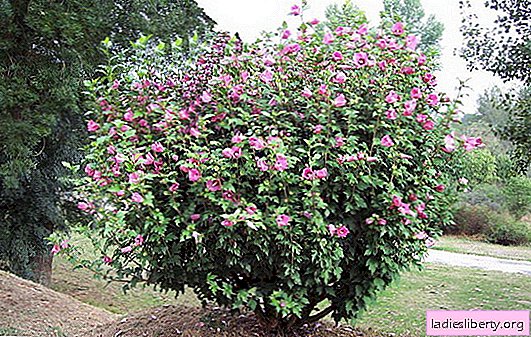
Hibiscus garden is a shrub or tree with large dark green leaves and huge single flowers of various colors.
This plant is great for decorating any personal plot.
In Russia, it is grown in areas with a temperate climate, but best of all it takes root in the southern latitudes, where it can be found quite often.
In the taiga zone, garden hibiscus is much less common, because there it requires more careful care, including a winter shelter
The most popular species in our country is Syrian Hibiscus (or Chinese rose), which is widely used due to its frost resistance.
Hibiscus garden: planting, variety selection
Types of hibiscus (Syrian and hybrid) differ from each other in life form. Syrian hibiscus is a tree, and hybrid hibiscus is a perennial herb, and hybrid hibiscus is not so popular with Russian gardeners. Hibiscus garden has a huge number of varieties, the most famous of them are as follows:
• Alicante - a tree-like plant with large leaves and simple red flowers.
• Vayelit Ilar Double - is a shrub with erect skeletal shoots. The flowers have terry purple or blue with a red base of petals.
• Pink Giant - has pink large flowers, purple in the middle.
• Carneus Plenus - a bush with delicate pink flowers with a scarlet center.
• Diana - snow-white flowers in a corrugated edge.
• Anrara - characterized by simple yellow flowers that have a red core.
• Rose - flowers are large, double, saturated pink.
• Flamingo - has pink flowers with a red center.
Planting hibiscus garden is carried out by seeds or seedlings.
To grow a plant from a seedafter full prosperity, you need to collect boxes from the plant and extract the seeds.

In winter, the seeds should be soaked for a day in a warm solution of potassium permanganate (for disinfection). Then you need to prepare the soil. For this it is necessary to mix sand with peat in equal proportions, mix and put hibiscus seeds on the resulting substrate without sprinkling. It is necessary to cover the container with seeds of cellophane and put in a warm place. When the shoots appear, you need to ventilate and spray them. When the third leaf opens, the plant can be transplanted into a separate pot, adding humus there.
When planting adult seedlings You need to choose a well-lit place, protected from strong winds. It should also be noted that hibiscus prefers soils whose reaction is slightly shifted to the acid side. To increase the acidity of the substrate and improved aeration in the future, in the autumn, dig the soil, adding peat and sand, a little wood bark. Hibiscus is planted in open ground in spring, in March or April (depending on latitude). To do this, dig a hole so that it is larger than the capacity in which the seedling grows. 5 liters of water should be poured into the pit to moisten the soil. When water is absorbed, it is necessary to lay a drainage of charcoal along the bottom, set the hibiscus vertically and lower the roots of the plant into the hole, and cover it with earth.
Hibiscus garden: care (photo)
Caring for garden hibiscus is an easy task, it includes loosening the soil, watering, pruning shoots and periodic top dressing. Starting in early spring, the soil around the plant should be loosened 2 times a month (more often), while removing weeds. The life of a hibiscus flower is short-lived, but it blooms lushly, so you need to remove faded flowers.
In the hot season, garden hibiscus needs intensive irrigation, which is done when the soil has dried out after the previous irrigation. In dry summers, hibiscus needs to be watered daily.
To give the plant a beautiful shape and prevent thickening of shoots, hibiscus will have to be cut annually. Pruning is done in early spring, when the plant has not yet entered the vegetation phase. To form a tree, it is necessary to trim the side branches in the first year of life, leaving 2-3 buds and leave the trunk unchanged. In the second year and beyond, the side shoots are cut to 2 buds. Also, garden hibiscus care involves sanitary pruning: removal of non-viable branches and shoots growing inside the crown. Last year's shoots are also trimmed to 1/3 id of length - this stimulates the laying of new flower buds. Before and after trimming, the proportion of shoots should match the photo.

Hibiscus garden: top dressing
In warm areas of the country, garden hibiscus blooms from June to September. To intensify the flowering of the plant, you need to make fertilizing and fertilizing on time. Hibiscus responds well to potash fertilizers and is capricious if it receives a lot of phosphorus (therefore, its content in top dressing should be minimal). You need to feed 2 times a month, and not only through the root system, but also through the leaves. For root nutrition, you can use the liquid fertilizer "Aquamarine Floral", which in addition to potassium, phosphorus and nitrogen contains a set of mineral elements needed by the plant. For fertilizing by spraying, the “Lignohumate BM potash” is well suited. These fertilizers are used in the proportions indicated on the instructions.
Also, 1-2 times a month, hibiscus can be fed with natural organic fertilizer: for this you need to take half a bucket of manure, fill it with water, adding one glass of wood sol and 0.5 cup superphosphate. This mixture is infused for 14 days, after which it is filtered and poured into storage containers. In use, the resulting liquid is diluted with water in a ratio of 1:10.
Hibiscus garden: pests and diseases (photo)
Garden hibiscus is a fairly resistant plant, and with proper care it rarely gets sick. But sometimes you can notice on the plant the following diseases and pests that cause them:
Leaf chlorosis. It appears in the yellowing of the leaves, as in the photo, and their subsequent shedding. The cause of this phenomenon may be an alkaline soil reaction, as well as a lack of trace elements of iron and magnesium. You can increase the acidity of the substrate by adding peat, to make up for the lack of trace elements, you need to choose the right fertilizer.
Aphid. Sometimes the leaves of the plant begin to turn yellow, and the buds do not bloom and fall off. A closer look reveals small black insects on the hibiscus, as in the photo.

For the control of aphids, multiple sprayings with the preparations "Fitoverma", "Decis", "Actellika" are suitable.
Spider mite. If the hibiscus leaves begin to dry up and curl up with the formation of a white fluffy coating, then the spider mite is to blame. He feels especially comfortable in warm weather with excessive humidity. To combat, it is recommended to wipe the leaves with a saturated soapy solution. More radical means are Lightning, Akarin, Fitoverm and Vertimek, which should be used in accordance with the instructions.
Shields. They cause folding and falling of foliage. Scabies can be seen in the form of brown spots on the shoots of hibiscus. Actellik is suitable for fighting, 1.5 ml of which is dissolved in 1 liter of water and sprayed on the plant.
Worms. They accumulate around the veins on the front side of the leaf and feed on plant juices. To combat them, mineral oil is well suited, which is used to process places of accumulation of scale insects. A greasy film limits pests' access to oxygen - and they die. This procedure must be carried out in the shade, avoiding direct sunlight.
Why hibiscus is the flower of death
This belief comes from China. There it is believed that the untimely flowering of hibiscus portends the death of its owner or one of his relatives.
The Chinese believe that in order to avoid trouble, you need to burn the flower after it blooms. But these superstitions in the modern scientific world do not find any confirmation, and the untimely flowering of the plant and the subsequent death of its owner are regarded as coincidences that are not connected with each other.
Moreover, scientists consider hibiscus to be a useful flower, because it releases phytoncides, thereby healing the air.











